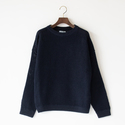- トップページ/
- Kitchen/
- Japanese porcelain/
- KUTANI WARE GRAPES AND SQUIRREL 19cm PLATE
KUTANI WARE GRAPES AND SQUIRREL 19cm PLATE
A picture plate that you can enjoy with your eyes
Grape and squirrel seven-inch medium plate of Miyamoto Taizando, where the slightly drawn squirrel is eye-catching. It looks like he's jumping when he waits for the food, and he smiles. One of the craft patterns, grape arabesque, is drawn on the edge. It started in ancient Egypt and was transmitted to China and Japan through the Silk Road. By adding a lovely squirrel to this classic pattern, it has become a vessel with some warmth.
A vessel to enjoy serving
The grape and squirrel seven-inch medium plate, with its lovely grape arabesque and lively squirrel motif, is just the right size for serving the main dish for one person. While retaining the gorgeousness of Kutani ware, it is somewhat simple and fits well into modern dining tables. The reason why you can use it for a long time is that you will not get tired of the gentle painting that makes use of the margins, and that it is light and easy to handle. It is recommended to arrange for the number of family members, and it is also a wonderful gift for wedding gifts and loved ones.
The rim is decorated with a small decoration called a ridge flower. Ryoka is a shape in which a notch is made in the rim of a round tableware and a part of the tip of the petal is slightly sharpened. The shape often found on round plates and pots is like a large flower. This understated decoration adds an accent to your usual dining table. Also, with the same pattern, it is perfect for serving sashimi and vinegared dishes kutani grapes and squirrel boat-shaped plate. One of the ways to enjoy it is to arrange it as a set.
The charm of Kutani ware
Miyamoto Taizando (Miyamoto Taizando) opened in 1909. Taizan Kiln is located in Komatsu, Ishikawa Prefecture, and focuses on colored porcelain, which is said to be the mainstream tradition of Kutani ware. It was said that it was Kutani ware store when it was founded, but as Taizando has been handed down for three generations, as a result of asking "What is a fun vessel to use?" It seems that the temple has been transformed into a pottery workshop that makes original vessels.
While sticking to the plump and thick blue (green), purple, navy blue, and yellow overpaintings peculiar to Kutani, the two "traditional and modern" and "enjoyable vessels" are shaped by craftsmanship to create an easy-to-use pattern. We summarize and send it to our daily dining table.
Kutani ware is a traditional Japanese craft that is said to have been developed by the Maeda clan, the lord of the Kaga domain, in the Edo period, when he discovered ceramic clay and began making porcelain. is. The feature is that it is easy to use as tableware by adding various patterns to a clear white base, and it is pleasing to the eyes, and the color painting that shines on the white background of the hard glass material of porcelain is attractive.
Generally, Kutani ware is expressed in five colors (blue, yellow, dark blue, purple, red), but Miyamoto Taizando counts the white color of the fabric as one color, and uses it for painting with "Rokusai". I am particular about it. Modern design that makes use of such margins will become a vessel for living in the modern lifestyle.
| Size | Diameter 19cm / 7.5in
Height 3cm / 1.2in |
| Weight | 330g |
| Material | Porcelain |
| Country of origin | Japan |
| Compatibility | Microwave: o
Dishwasher: o Oven: x |
Notice
-
- Due to the nature of the product, there may be slight individual differences in size, pattern, and color. Please note.
- Pottery has a warm texture and individuality that mass-produced ones do not have. This product is recommended for those who enjoy that everything is unique and unique.
ブランド紹介
MIYAMOTO TAIZANDO
MIYAMOTO TAIZANDO is a brand of Kutani ware founded in 1909 in Komatsu City, Ishikawa Prefecture, Japan. Based on Ko-kutani, which is the oldest style of Kutani ware, TAIZANDO manufactures handpainted Kutani ware with bright colors. The brand pursues the modern style of Kutani ware that we can all enjoy using on everyday dining.
| 商品 | 価格(税込) | 在庫 | 個数 | |
|---|---|---|---|---|

KUTANI WARE GRAPES AND SQUIRREL 19cm PLATE
送料:一配送660円・11,000円以上で送料無料(一部地域除く)
|
¥4,015(税込) |
◯
|
Added to cart
ぶどうとリス 七寸中皿には、他にもこんな仲間がいます
-
MIYAMOTO TAIZANDO
KARAKO NEW MOKKO TYPE 5 SUN¥3,190(税込)
-
MIYAMOTO TAIZANDO
JAPANESE PLATE WITH TWIN FISH DESIGN¥3,776(税込)
-
MIYAMOTO TAIZANDO
BIRD AND BEAST CARICATURE CLOUD TYPE SMALL BOWL 5 PIECE SET¥10,963(税込)
-
MIYAMOTO TAIZANDO
KUTANI WARE RED PATTERNED PLATE¥5,115(税込)
-
MIYAMOTO TAIZANDO
KUTANI WARE RED PATTERNED BOWL¥4,345(税込)
-
MIYAMOTO TAIZANDO
KUTANI FLOWERS AND BIRDS PLATE¥8,965(税込)
-
MIYAMOTO TAIZANDO
KUTANI RED PATTERNED PLATE¥3,190(税込)
-
MIYAMOTO TAIZANDO
KUTANI BIRD ON IVY RECTANGULAR PLATE¥2,217(税込)
-
MIYAMOTO TAIZANDO
KUTANI HEXAGONAL SMALL PLATES FRUITS SET OF 5¥5,775(税込)
-
MIYAMOTO TAIZANDO
KUTANI WARE SQUARE SMALL PLATES LANDSCAPE SET OF 5¥4,950(税込)
-
MIYAMOTO TAIZANDO
KUTANI WARE GRAPES AND SQUIRREL BOAT-SHAPED PLATE¥2,640(税込)
-
MIYAMOTO TAIZANDO
SOBA CUP YABANE PATTERN SET OF 2¥9,823(税込)
-
MIYAMOTO TAIZANDO
KUTANI KINGFISHER RECTANGULAR PLATE¥2,200(税込)
-
MIYAMOTO TAIZANDO
KUTANI WARE FLOWER AND BUTTERFLY PATTERN¥1,886(税込)
-
MIYAMOTO TAIZANDO
KUTANI SWALLOW OVAL PLATE¥4,097(税込)
-
MIYAMOTO TAIZANDO
KUTANI CHOJU-GIGA OVAL PLATE¥1,595(税込)
-
MIYAMOTO TAIZANDO
KUTANI OCTAGONAL SMALL PLATES FLOWER SET OF 5¥5,599(税込)
-
MIYAMOTO TAIZANDO
PAIR OF KUTANI CHOJU-GIGA RICE BOWLS¥5,742(税込)
ぶどうとリス 七寸中皿を見た人はこんなアイテムも見ています
-
KUTANI CHOEMON
KUTANI SOY SAUCE DISPENSER¥8,800〜(税込)
-
KOSEN
FLOWER PLATE¥5,500〜(税込)
-
GATOMIKIO
USUBIKI BOWL WHITE¥8,800(税込)
-
HYOZAEMON
Octagonal Chopsticks Set of 2 pairs boxed¥8,030(税込)
-
TOJIKITONYA
AO anti-large bowl set¥7,260(税込)
-
BAIZANKILN
OVAL PLATE¥3,905(税込)
-
SONOBE
OVALWOOD PLATE¥6,600(税込)
-
AIZAWA Wood Works
CHERRY MEDIUM PLATE¥4,950(税込)
-
NOUSAKU
SAKURA TRAY AND CHOPSTICK REST¥17,930(税込)
-
RISO
Glass for sake¥3,630〜(税込)




















%20MILK.jpg)
















.jpg)




































.jpg)



.jpg)
















































































